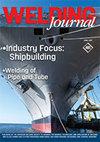利用激光束振荡的窄坡口激光电弧复合焊接厚截面HSLA钢
IF 1.4
3区 材料科学
Q2 METALLURGY & METALLURGICAL ENGINEERING
引用次数: 1
摘要
采用正弦振荡激光器对高强度低合金(HSLA)钢进行了窄坡口激光-电弧复合焊接。然后分析了激光束振荡幅度和空间约束对电弧行为、熔滴转移、焊缝几何形状和焊珠不完全熔合的影响。由于最小电弧电压原理和固有的电弧自我调节,当激光器不振荡时,观察到电弧阴极光斑典型地附着在一侧侧壁上。结果,熔池没有扩散到间隙的整个宽度,导致熔合不完全。当激光束沿正弦路径振荡时,振幅两侧的能量密度均高于中心线,焊缝的纵横比减小。发现沿中心线的速度远高于振幅两侧的速度。在振荡梁的作用下,熔池沿宽度方向振荡,形成凹形表面,促进了槽侧壁的熔化,抑制了侧壁的不完全熔合缺陷。利用60 mm厚的焊缝,验证了激光振荡辅助NGHW的技术可行性,该焊缝具有平滑的层过渡和无可见缺陷的特点。本文章由计算机程序翻译,如有差异,请以英文原文为准。
•Narrow Groove Laser-Arc Hybrid Welding of Thick-Sectioned HSLA Steel Using Laser Beam Oscillation
In this study, a sine-oscillating laser was used to obtain narrow groove laser-arc hybrid welding (NGHW) of high-strength low-alloy (HSLA) steel. Then the effects of laser beam oscillation amplitude and space constraint on arc behavior, droplet transfer, weld geometry, and incomplete fusion of the weld beads were analyzed. Due to the minimum arc voltage principle and inherent arc self-regulation, when the laser did not oscillate, it was observed that the arc cathode spot was typically attached to one sidewall. As a result, the molten pool did not spread through the entire width of the gap , resulting in incomplete fusion. When the laser beam oscillated in a sinusoidal path, the energy density on both sides of the amplitude was higher than the centerline, and the aspect ratio of the weld decreased. The speed of the beam along the centerline was found to be much higher than the speed on both sides of the amplitude. The molten pool oscillated in the width direction under the action of the oscillating beam, forming a concave surface, which promoted melting of the sidewalls of the groove and suppressed incomplete fusion defects in the sidewalls. The technical feasibility of NGHW assisted by laser beam oscillation was verified using a 60-mm-thick weld, which was haracterized by a smooth layer transition and the absence of visible defects.
求助全文
通过发布文献求助,成功后即可免费获取论文全文。
去求助
来源期刊

Welding Journal
工程技术-冶金工程
CiteScore
3.00
自引率
0.00%
发文量
23
审稿时长
3 months
期刊介绍:
The Welding Journal has been published continually since 1922 — an unmatched link to all issues and advancements concerning metal fabrication and construction.
Each month the Welding Journal delivers news of the welding and metal fabricating industry. Stay informed on the latest products, trends, technology and events via in-depth articles, full-color photos and illustrations, and timely, cost-saving advice. Also featured are articles and supplements on related activities, such as testing and inspection, maintenance and repair, design, training, personal safety, and brazing and soldering.
 求助内容:
求助内容: 应助结果提醒方式:
应助结果提醒方式:


